20.3: Productivity
- Last updated
- Save as PDF
- Page ID
- 3563

- Boundless
- Boundless
The Importance of Productivity
Increasing productivity is a rare win-win, improving the standard of living from a governmental, commercial and consumer perspective.
learning objectives
- Use the production function to determine how different variables affect output and productivity
Productivity is essentially the efficiency in which a company or economy can transform resources into goods, potentially creating more from less. Increased productivity means greater output from the same amount of input. This is a value-added process that can effectively raise living standards through decreasing the required monetary investment in everyday necessities (and luxuries), making consumers wealthier (in a relative sense) and businesses more profitable.
From a broader perspective, increased productivity increases the power of an economy through driving economic growth and satisfying more human needs with the same resources. Increased gross domestic product (GDP) and overall economic outputs will drive economic growth, improving the economy and the participants within the economy. As a result, economies will benefit from a deeper pool of tax revenue to draw on in generating necessary social services such as health care, education, welfare, public transportation and funding for critical research. The benefits of increasing productivity are extremely far-reaching, benefiting participants within the system alongside the system itself.
Productivity Beneficiaries
To expand upon this, there are three useful perspectives in which to frame the value in improving productivity within a system from an economic standpoint:
- Consumers/Workers: At the most micro level we have improvements in the standard of living for everyday consumers and workers as a result of increased productivity. The more efficiency captured within a system, the lower the required inputs (labor, land and capital ) will be required to generate goods. This can potentially reduce price points and minimize the necessary working hours for the participants within an economy while retaining high levels of consumption.
- Businesses: Businesses that can derive higher productivity from a system also benefit from creating more outputs with the same or fewer inputs. Simply put, higher efficiency equates to better margins through lower costs. This allows for better compensation for employees, more working capital and an improved competitive capacity.
- Governments: Higher economic growth will also generate larger tax payments for governments. This allows governments to invest more towards infrastructure and social services (as noted above).
Factors Affecting Productivity
The final important consideration in assessing productivity potential is the production-possibility frontier (PPF), which essentially outlines the maximum production quantity of two goods (in the scope of our current technological capacity and supply). This demonstrates the confinement of productivity, and thus is well captured in the Leontief production function. The critical takeaway here is that the production fu nction will generally be affected by two things: overall supply and technological capabilities. Note that demand does not come into account in altering the production function or overall productivity potential. The illustration in the following figure demonstrates an increase in PPF, thus affecting the production function.
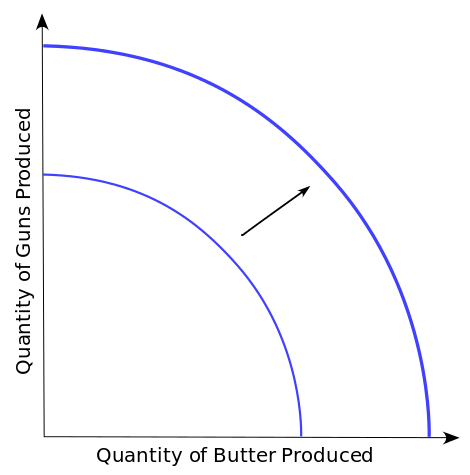
Production-Possibility Frontier Expansion: In this graph, the prospective production-possibility frontier shifts to the right, implying a higher supply or improved technological production ability of the two goods being discussed (in this case guns and butter).
Measuring Productivity
Productivity is represented by production functions, and is the amount of output that can be generated from a set of inputs.
learning objectives
- Discuss different ways to measure productivity and productivity growth
Productivity, in economic terms, measures inputs and outputs to derive overall production efficiency within a system. Simply put, it measures how much can you get out of what you put into a given system. Increased productivity means more output is produced from the same amount of inputs. In order to generate meaningful information about the productivity of a given system, production functions are used to measure it. Understanding the way in which productivity metrics function, one can more comprehensively grasp the concept and employ it in a meaningful way.
Production Function
From an economic standpoint, the production function demonstrates the tangible output created as a result of a production process including all tangible inputs. The objective in employing this perspective is to pursue allocative efficiency within the process (as opposed to technical or logistical efficiency, as engineers or supply chain managers may be pursuing). This means that the production function identifies optimal inputs (and consequent outputs) to satisfy the needs of a given population via a particular production process. While different economic perspectives often identify different factors of production (i.e. inputs in the system), it is useful to identify the following:
- Land/Natural Resources: Products of nature that have economic value, including metals/agriculture/livestock/land/etc.
- Capital: This is a broad term, capturing more than just financing and investment. Capital can also be fixed capital (i.e. machinery, equipment, buildings, computers, etc.) or working capital (i.e. goods, inventory and liquid assets). Concepts of human, intellectual and social capital is also highlighted, separate from the concept of labor below, which can affect the efficiency of a process.
- Labor: The human skills, time and efforts necessary to add value to the production process. This can range from highly tangible inputs (working hours, products assembled) to highly intangible inputs (entrepreneurship, experience, technology skills, etc.).
Conceptually, the production function makes certain assumptions of the maximum potential production, availability of inputs and demand for outputs to create a boundary of potential production. This will include the derivation of a marginal product for each factor (see ), or essentially the extra output that can be created for each additional unit of input. Naturally, this is theoretically subjected to the concept of diminishing marginal returns, where the marginal product of a given input (in the figure we are illustrating labor) will fall as the starting points for quantity rise.
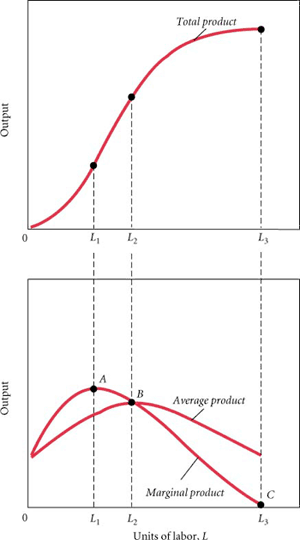
Product Function: This graph illustrates the way in which a production function identifies the relationship between a quantity of inputs and the resulting output of a given product. This takes into account marginal and average product, which are indicative of the change in efficiency based upon inputs.
Forms of the Production Function
There are a variety of ways to approach the measuring of productivity in the context of production functions:
- Functional Form: One way a production function can be illustrated is through the following equation \(Q=f(X_1,X_2,X_3,…,X_n)\). In this circumstance ‘Q’ is the quantity of output while each ‘x’ is a factor input.
- Linear Form: While this is generally not practical in practice, it is also possible to represent this in a linear mathematical fashion if parameters (a, b, c, and d below) are identified: \(Q=a+bX_1+cX_2+dX_3+…\)
- Cobb-Douglas Production Function: One of the most useful frameworks, that allow for a technological relationship to be illustrated between the amount of two (or more) inputs is the Cobb-Douglas model. This is most often used to illustrate how physical capital and labor effect one another (see ). In the equation, ‘Y’ is total production while ‘L’ is labor, ‘K’ is capital, ‘A’ is total factor productivity and the alpha and beta are the elasticity of the two inputs. \(Y=AL^βK^α\)
- Leontief Production Function: The Leontief Production Function assumes a technologically pre-determined set of proportions for the factors of production (i.e. no ability to substitute between factors. This is specifically designed to capture minimums or limiting cases of production. The ‘z’s in the equation are inputs of specific goods while the a and b represent the technological determined constants and ‘q’ being the overall output: \(q=\mathrm{Min}(\frac{z_1}{a},\frac{z_2}{b})\)
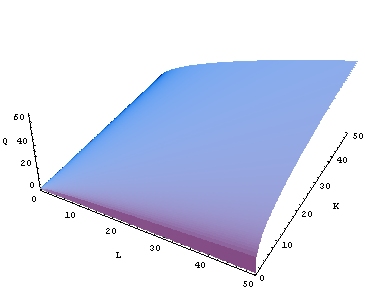
Cobb-Douglas Production Function: This is an illustration of a two-input Cobb-Douglas Production Function, where the ability to benchmark an output in comparison to two separate quantities of inputs is feasible.
Impacts of Technological Change on Productivity
Technological advances play a crucial role in improving productivity, and thus the standard of living in a system.
learning objectives
- Analyze how changes in technology affect productivity and productivity growth
Productivity measures the way in which an economic system or business can leverage available functional inputs to generate meaningful outputs. This concept drives economies towards higher degrees of efficiency in production and thus higher economic growth and standards of living. As a result, improving productivity is a critical objective for societies to increase their relative wealth. Technological advances play a crucial role in improving productivity, and thus the standard of living in a system.
Production-Possibility Frontier
Productivity growth is bound by what is called the production-possibility frontier (PPF), which essentially stipulates a series of maximum amounts of two commodities that can be generated using a fixed amount the relevant factors of production. In the context of a given PPF, only an increase in overall supply of inputs or a technological advancement will allow for the PPF to shift out and allow for an increase in potential outputs of both goods simultaneously (represented by point ‘X’ in the figure). The shift due to changes in technology represents increased productivity. This is a critical component in understanding the role of technology in productivity, as it is a primary influence on increasing the prospective production possibilities.
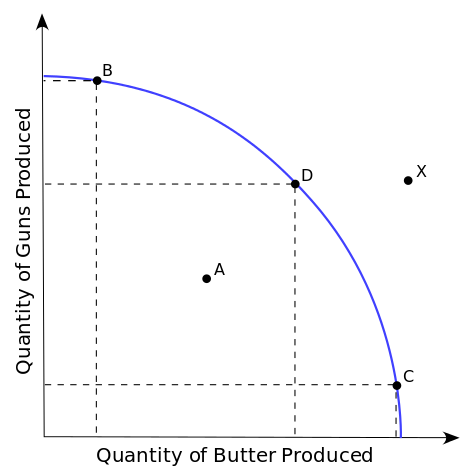
Production-Possibility Frontier (PPF): This graph illustrates the varying theoretical takeaways from a PPF chart. On this, points B, C, and D all lie on a maximum output level, while A is representative of a realistic but inefficient amount. X is beyond the scope of the PPF graph, and thus requires a technological improvement or increase in supply.
Technological Advances: Past, Present, and Future
The variance in technological advances that have driven productivity upwards is remarkable, underlining the ongoing importance of focusing on technology as a primary change agent. Innovative advances in technologies can be either leaps or increments, although the larger technological advances tend to take the limelight. In general, there are a particularly notable categories:
- Energy: Historically, animals and humans were the primary energy input for the generation of products. This was extremely expensive and time-consuming relative to more modern ways to power things, and has been improved upon dramatically over time. Electricity, heat, steam, water, solar, and a wide variety of other energy capturing methodologies have dramatically increased efficiency while freeing up man hours.
- Transportation and Industrial Machinery: Trade has been a part of human history for nearly as long as civilizations knew of one another, bartering being the a central component of human interaction. The improvement of trade venues, such as boats, cars, planes, trains, etc. have enabled rapid increases in trade quantity and efficiency. Similarly, industrial machinery utilizing similar vehicles have enabled mass increases in scale and efficiency, particularly agriculture.
- Communication: Needless to say, the internet and mobile communications have rapidly expedited the transmission of knowledge, data, information, and networking. This has resulted in a massive increase in synergy across the world, alongside the development of economic learning and development.
- Logistics: Increases in technological systems is generally considered to be a tangible innovation, but is not limited to such. Improvements in the ways in which we do things is often just as useful. Henry Ford is a classic example of this, innovating the assembly line to maximize the efficiency the production process through strategic implementation of labor roles.
Implications on Productivity
Measuring the effects of technology on productivity is a difficult pursuit. It is generally approached through metrics such as Gross Domestic Product (GDP), GDP per capita, and Total Factor Productivity (TFP). The former two attempt to capture the overall output of a given economy from a macro-environmental perspective. The latter is slightly more interesting, attempting to measure technologically driven advancement through noting increases in overall output without increases in inputs. This is done through utilizing production function equations and identifying when the output is greater than the supposed input, implying an advance in the external technological environment. This system is more specifically tailored for technological change than GDP.
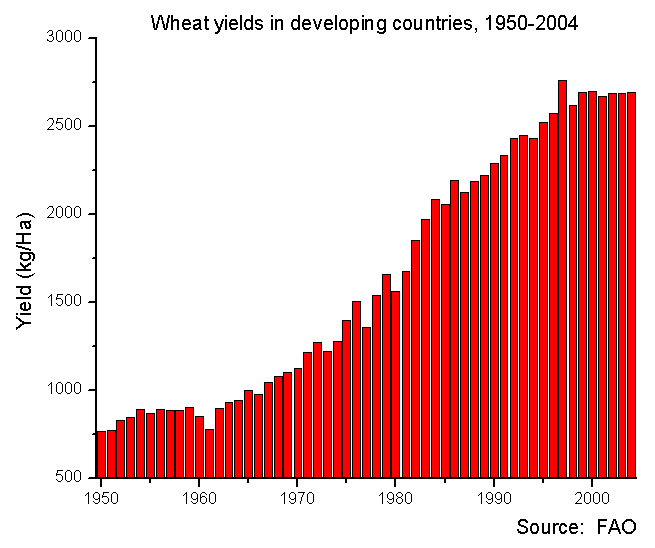
Wheat Yield: Over the past 60 years, wheat yield (PPF) has dramatically improved as a result of critical technological and logistic advancements.
Key Points
- Productivity is essentially the efficiency in which a company or economy can transform resources into goods, potentially creating more from less.
- Productivity can effectively raise living standards through decreasing the required monetary investment in everyday necessities (and luxuries), making consumers wealthier and business more profitable and in turn enabling higher government tax revenues.
- Economists looking to measure this productivity within a given system generally leverage production functions to determine how different factors of production (i.e. inputs ) affect the overall output.
- The final important consideration in assessing productivity potential is the production-possibility frontier (PPF), which outlines the maximum production quantity of two goods in the scope of our current technological capacity and supply.
- From an economic standpoint, the production function demonstrates the tangible output created as a result of a production process including all tangible inputs.
- The objective in employing this perspective is to pursue allocative efficiency within the process (as opposed to technical or logistical efficiency, as engineers or supply chain managers may be pursuing).
- Generally speaking, the factors of production include land, labor and capital.
- There are a variety of ways to approach the measuring of productivity in the context of production functions, including the functional form, the linear form, the Cobb-Douglas production Function and the Leontief Production Function.
- Productivity growth is bound by what is called the production-possibility frontier (PPF), which essentially stipulates a series of maximum amounts of two commodities that can be generated using a fixed amount the relevant factors of production.
- The variance in technological advances that have driven productivity upwards is remarkable, underlining the ongoing importance of focusing on technology as a primary change agent.
- Advances in energy systems, transportation, communication, logistics, and a variety of other technological trajectories have greatly enabled an increased standard of living through advancing productivity.
- Measuring the affects of technology on productivity is a difficult pursuit. It is generally approached through metrics such as Gross Domestic Product ( GDP ), GDP per capita, and Total Factor Productivity (TFP).
Key Terms
- productivity: the rate at which goods or services are produced by a standard population of workers.
- Production function: Relates physical output of a production process to physical inputs or factors of production.
- Allocative efficiency: A type of economic efficiency in which economy/producers produce only those types of goods and services that are more desirable in the society and also in high demand.
- Liquid assets: An asset in the form of money or cash in hand, or an asset which can be quickly converted into cash without losing much value.
- Production-Possibility Frontier (PPF): A graph that shows the various combinations of amounts of two commodities that could be produced using the same fixed total amount of each of the factors of production.
LICENSES AND ATTRIBUTIONS
CC LICENSED CONTENT, SPECIFIC ATTRIBUTION
- Productivity model. Provided by: Wikipedia. Located at: en.Wikipedia.org/wiki/Productivity_model. License: CC BY-SA: Attribution-ShareAlike
- Cobbu2013Douglas production function. Provided by: Wikipedia. Located at: en.Wikipedia.org/wiki/Cobb%E2...ction_function. License: CC BY-SA: Attribution-ShareAlike
- Productivity. Provided by: Wikipedia. Located at: en.Wikipedia.org/wiki/Productivity. License: CC BY-SA: Attribution-ShareAlike
- Production-possibility frontier. Provided by: Wikipedia. Located at: en.Wikipedia.org/wiki/Product...ility_frontier. License: CC BY-SA: Attribution-ShareAlike
- Production function. Provided by: Wikipedia. Located at: en.Wikipedia.org/wiki/Production%20function. License: CC BY-SA: Attribution-ShareAlike
- productivity. Provided by: Wikipedia. Located at: en.Wikipedia.org/wiki/productivity. License: CC BY-SA: Attribution-ShareAlike
- Provided by: Wikimedia. Located at: upload.wikimedia.org/wikipedi..._expansion.svg. License: CC BY-SA: Attribution-ShareAlike
- Productivity. Provided by: Wikipedia. Located at: en.Wikipedia.org/wiki/Productivity. License: CC BY-SA: Attribution-ShareAlike
- Productivity model. Provided by: Wikipedia. Located at: en.Wikipedia.org/wiki/Productivity_model. License: CC BY-SA: Attribution-ShareAlike
- Production function. Provided by: Wikipedia. Located at: en.Wikipedia.org/wiki/Production_function. License: CC BY-SA: Attribution-ShareAlike
- Leontief production function. Provided by: Wikipedia. Located at: en.Wikipedia.org/wiki/Leontie...ction_function. License: CC BY-SA: Attribution-ShareAlike
- Cobbu2013Douglas production function. Provided by: Wikipedia. Located at: en.Wikipedia.org/wiki/Cobb%E2...ction_function. License: CC BY-SA: Attribution-ShareAlike
- Productivity. Provided by: Wikipedia. Located at: en.Wikipedia.org/wiki/Productivity. License: CC BY-SA: Attribution-ShareAlike
- Marginal product. Provided by: Wikipedia. Located at: en.Wikipedia.org/wiki/Marginal_product. License: CC BY-SA: Attribution-ShareAlike
- Allocative efficiency. Provided by: Wikipedia. Located at: en.Wikipedia.org/wiki/Allocative%20efficiency. License: CC BY-SA: Attribution-ShareAlike
- Liquid assets. Provided by: Wiktionary. Located at: en.wiktionary.org/wiki/Liquid+assets. License: CC BY-SA: Attribution-ShareAlike
- Provided by: Wikimedia. Located at: upload.wikimedia.org/wikipedi..._expansion.svg. License: CC BY-SA: Attribution-ShareAlike
- Provided by: Wikimedia. Located at: upload.wikimedia.org/wikipedi...al_Product.gif. License: CC BY-SA: Attribution-ShareAlike
- Provided by: Wikimedia. Located at: upload.wikimedia.org/wikipedi...bb-Douglas.jpg. License: CC BY-SA: Attribution-ShareAlike
- Productivity. Provided by: Wikipedia. Located at: en.Wikipedia.org/wiki/Productivity. License: CC BY-SA: Attribution-ShareAlike
- Productivity model. Provided by: Wikipedia. Located at: en.Wikipedia.org/wiki/Productivity_model. License: CC BY-SA: Attribution-ShareAlike
- Productivity improving technologies (historical). Provided by: Wikipedia. Located at: en.Wikipedia.org/wiki/Product...s_(historical). License: CC BY-SA: Attribution-ShareAlike
- Total factor productivity. Provided by: Wikipedia. Located at: en.Wikipedia.org/wiki/Total_f...r_productivity. License: CC BY-SA: Attribution-ShareAlike
- Production-possibility frontier. Provided by: Wikipedia. Located at: en.Wikipedia.org/wiki/Product...ility_frontier. License: CC BY-SA: Attribution-ShareAlike
- Production-Possibility Frontier (PPF). Provided by: Wikipedia. Located at: en.Wikipedia.org/wiki/Product...ontier%20(PPF). License: CC BY-SA: Attribution-ShareAlike
- productivity. Provided by: Wikipedia. Located at: en.Wikipedia.org/wiki/productivity. License: CC BY-SA: Attribution-ShareAlike
- Provided by: Wikimedia. Located at: upload.wikimedia.org/wikipedi..._expansion.svg. License: CC BY-SA: Attribution-ShareAlike
- Provided by: Wikimedia. Located at: upload.wikimedia.org/wikipedi...al_Product.gif. License: CC BY-SA: Attribution-ShareAlike
- Provided by: Wikimedia. Located at: upload.wikimedia.org/wikipedi...bb-Douglas.jpg. License: CC BY-SA: Attribution-ShareAlike
- Provided by: Wikimedia. Located at: upload.wikimedia.org/wikipedi...tier_Curve.svg. License: CC BY-SA: Attribution-ShareAlike
- Provided by: Wikimedia. Located at: upload.wikimedia.org/wikipedi..._1951-2004.png. License: CC BY-SA: Attribution-ShareAlike

